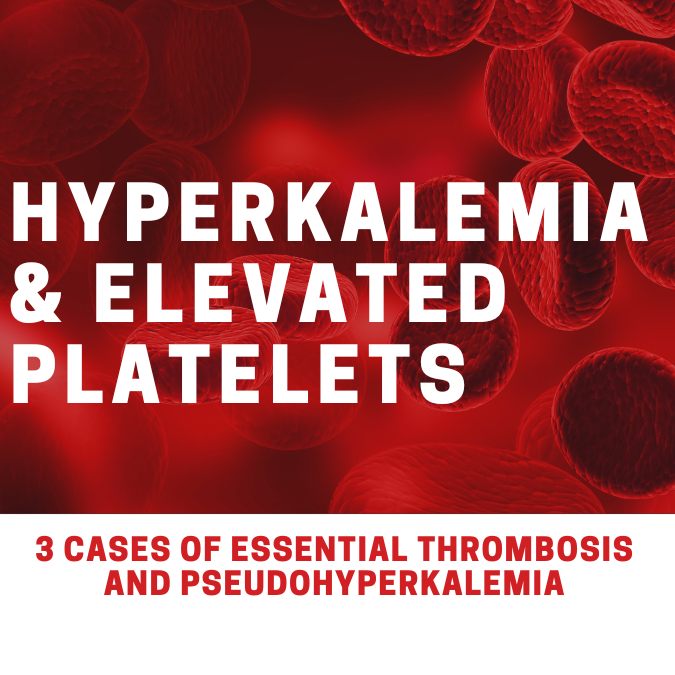In today’s post I am reviewing three case study that explored pseudohyperkalemia for people living with thrombocytosis.
What is pseudohyperkalemia?
According to the article, pseudohyperkalemia occurs when the serum potassium value is high but the plasma potassium value is normal.
Case # 1
The authors describe a case of an 82 year old, with a history of A. Fib, Essential Thrombocytosis and Tricipsid Value Regurgitation. She presented to the ER for lower limb weakness. Routine chemistry revealed that she had a serum potassium of 5.68mmol/L. They administered both glucose and insulin to correct the potassium. She was not on any medications that predispose people to hyperkalemia (no RAASi, no potassium supplements etc).
Over the course of her hospital stay, her potassium remained consistently above 5.0mmol/L. They checked her potassium 23 times, of these 57.5% were above 5.0mmol/L. Her highest potassium reading was 6.56mmol/L. She had normal serum creatinine levels (no kidney failure).
During her admission, she had 40 CBCs completed. 90% of the time her platelets were high enough to class her as having thrombocytosis (a reading above 450). Her platelets an averaged 689. Her hemoglobin remained OK, ruling out in-vitro hemolysis.
The endocrinologists recommended checking her plasma potassium values, and they found these values consistently within the normal range.
Discussion
Pseudo hyperkalemia was first described in 1955 as a difference of greater than 0.4mmol/L between serum and plasma potassium values. Cases of pseudohyperkalemia also must present with:
- the absence of ECG changes associated with hyperkalemia
- Lack of symptoms of hyperkalemia
- Not respond to classical hyperkalemia treatment
What causes of pseudo hyperkalemia?
According to the article, the main causes are:
- Prolonged tourniquet application
- Hemolysis during the puncture
- Samples being centrifuged prior to clot formation
- Leukocytosis (white cell counts above 70000)
- Thrombocytosis
- Familiar pseudo hyperkalemia
- Hereditary spherocytosis
What are the authors main recommendations?
For anyone with a platelet count above 600 and hyperkalemia, consider checking the plasma potassium vs the serum potassium.
Case # 2
In this article, the authors present the case of a 75-year-old with a history of diabetes. This patient came to the ER for reasons unrelated to hyperkalemia but was found to have a potassium level of 8 mEq/L. As with the previous case, both insulin and glucose were administered. During repeated potassium checks, his potassium remained elevated. When nephrology was consulted and noticed the platelets were very high, they ordered a plasma potassium test, which showed a level of 3.8 mEq/L.
What is the difference between plasma and serum potassium?
Both samples are blood-derived, but the handling during blood collection processing makes the difference.
Serum samples are collected in a tube with serum separating agents. This promotes clotting, creating a physical barrier between plasma and blood cells to stabilize the samples. Due to the lack of anticoagulants, the platelets degranulate, releasing intracellular potassium.
Plasma samples, on the other hand, are collected in a tube containing an anticoagulant such as heparin, which prevents the release of potassium from platelets.
Because people with thrombocytosis have high platelets, there is a greater release of intra-cellular potassium in these samples, leading to pseudo hyperkalemia.
Case # 3
The third case study describes what happened to a 73 year old with an eGFR of 8 and hyperkalemia. In her case, hemodialysis was started, but the hyperkalemia did not resolve. Her platelets were 1460. When her plasma and serum potassium values were checked, pseudohyperkalemia was confirmed. There was a difference of 1.23-2.35mmol/L between the serum and plasma over three consecutive checks. The authors concluded that this patient received unnecessary treatment as a result of pseudohyperkalemia.
Finally, the authors cite a reference that suggests that for adults living with kidney disease, the cut-off value for platelets necessitating a plasma potassium was 500 × 109/L.
Take Aways
When I think of pseudohyperkalemia I usually think about lab draw techniques. Less often am I thinking about disease processes that impact potassium levels. But after today, I am going to start look at the platelet count. Anything over 500 could be a sign that of pseudohyperkalemia.




Great insight Kelly! Have you suggested the testing of plasma potassium in your practice? How is this received by your nephrologists?
Hi Laila! Thanks for the comment! If something seems to be going on I have suggested testing plasma potassium and so far the nephrologists have been happy to work with this. How about you? Have you come across this in your practice? Are you able to get plasma potassium checked?